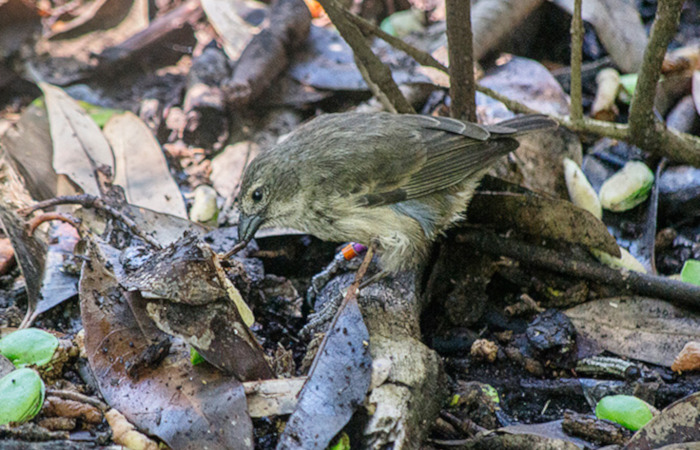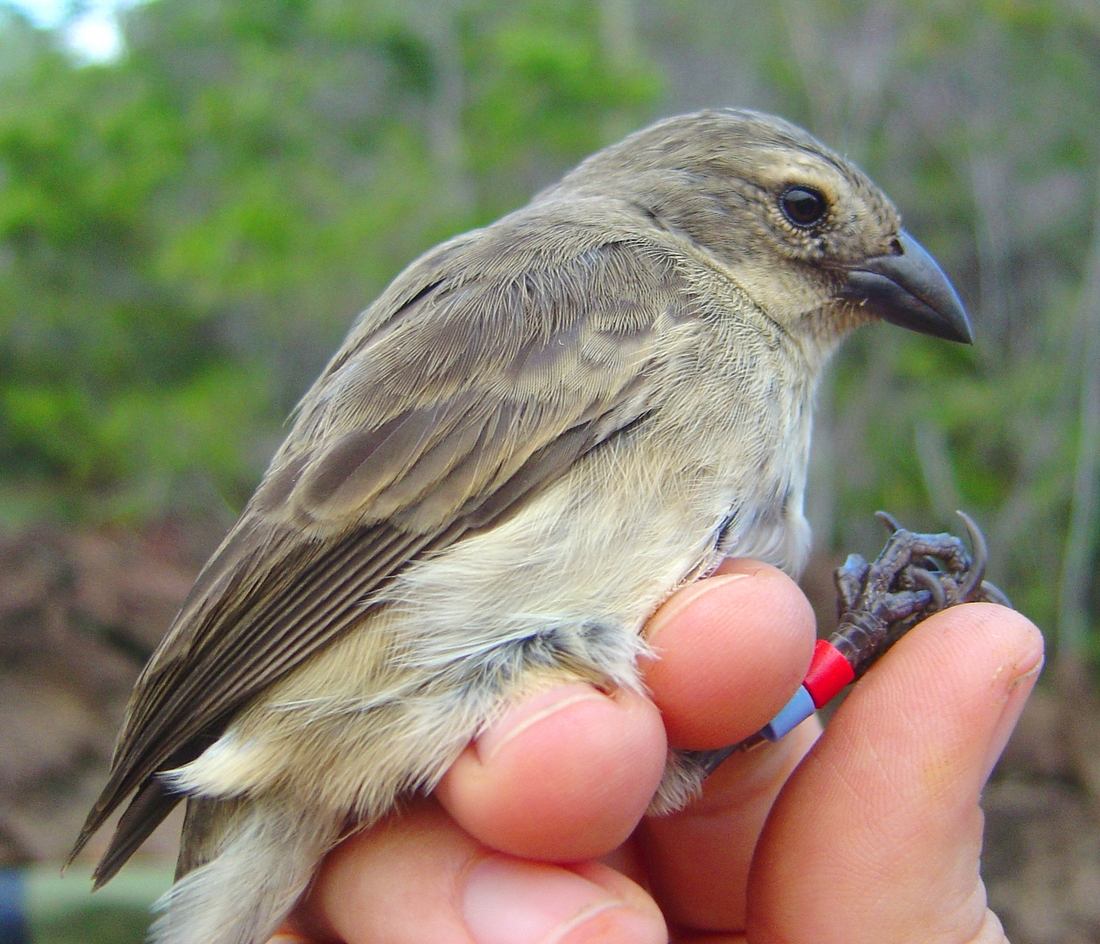Galapagos Species Database
The Galapagos Species Database shares the information about the species from our Natural History Collections.
Camarhynchus heliobates
Pinzón Manglero, Pinzón de mangle, Mangrove Finch



Threats: The species is threatened by the loss of habitats, mangrove are very restricted habitats on the Galápagos, rats, but the main current threat is probably the introduced fly Philornis downsi that causes high chick mortality of that small clutch species. Annual survey are performed and a captive breeding program (head starting) was started to try to support the populations while control of Philornis is still not possible. “Head starting” means collecting eggs, hand rearing chicks and return them into their original habitat once independent.
Domain
Eukaryota
Kingdom
Animalia
Phylum
Chordata
Class
Aves
Order
Passeriformes
Family
Thraupidae
Genus
Camarhynchus
Species
heliobates
Taxon category: Accepted
Syn.: Cactospiza heliobates (Snodgras & Heller, 1901); Geospiza heliobates Snodgras & Heller, 1901
Taxon origin: Endemic
Preference for an altitude zone in Galapagos: Coastal zone
Habitat preferences: Mixed mangroves with red (Rhizophora mangle), black (Avicennia germinans) and white (Laguncularia racemosa) mangrove trees preferred for both foraging and nesting.
Trophic role: Carnivorous
Reproduction mode: Exclusively sexual
Reproductive biology: Always nests in the outermost branches of the canopy of black (Avicennia germinans) and white (Laguncularia racemosa) mangrove trees and show a pronounced preference for the very high branches of black mangrove where available,. Red mangroves are an important feeding substrate but not used for nesting. Male displays in front of a dome shape nest. Once chosen, the pair either use this nest or build a new one. Only females incubate (two to three eggs), both feed the chicks. Fledglings stay for up to 6 weeks with a parent, either with the male while the female starts a new clutch, or, one with the female and the other with the male.
Distribution: Present on Playa Tortuga Negra, Caleta Black and Cartago on Isabela Island. Extinct on Fernandina.
- Wiedenfeld, D.A. (2006) Aves, the Galapagos Islands, Ecuador. Check List 2006 2(2): 1-27.
- Jiménez-Uzcátegui, G. Milstead, B., Márquez, C., Zabala, J., Buitrón, P., Llerena, A., et al. (2007) Galapagos vertebrates: endangered status and conservation actions. Galapagos Report 2006–2007. Charles Darwin Foundation, Puerto Ayora, p. 104–110.
- Harris, M.P. (1973) The Galápagos avifauna. Condor 75(3): 265-278.
- Swarth, H.S. (1931) The Avifauna of the Galapagos Islands. Occ. Pap. Calif. Acad. Sci. 18: 1-299.
- Wiedenfeld, D.A. Jiménez-Uzcátegui, G. (2008) Critical problems for bird conservation in the Galapagos Island. Cotinga 29: 22-27.
- Bisconti, M. Landini, W., Bianucci, G., Cantalamessa, G., Carnevale, G. Ragaini, L. & Valleri, G. (2001) Biogeographic relationships of the Galapagos terrestrial biota: parsimony analyses of endemicity based on reptiles, land birds and Scalesia land plants. J. Biogeogr. 28: 495-510.
- Fessl, B. Young, H. G., Young, R. P., Rodríguez-Matamoros, J., Dvorak, M. & Tebbich, S. (2010) How to save the rarest Darwin’s finch from extinction: the mangrove finch on Isabela Island. Philosophical Transactions of the Royal Society of London, Series B: Biological Sciences 365:1019–1030.
- Dvorak, M. Vargas, H., Fessl, B. & Tebbich, B. (2004) On the verge of extinction: a survey of the mangrove finch Cactospiza heliobates and its habitat on the Galápagos islands. Oryx 38:1-9.
- Fessl, B. Dvorak, M., Vargas, F. & Young, H. (2011) Recent conservation efforts and identification of the critically endangered mangrove finch Camarhynchus heliobates in Galapagos. Cotinga 33:27-33.
- Petren, K. Grant, B. & Grant, P. (1999) A phylogeny of Darwin's finches based on microsatellite DNA length variation. Proceedings of the Royal Society of London Series B-Biological Sciences 266:321-329.
- Christensen, R. Kleindorfer, S. (2009) Jack-of-all-trades or master of one? Variation in foraging specialisation across years in Darwin’s Tree Finches (Camarhynchus spp.). Journal of Ornithology 150:383-391.
- Farrington, H. Lawson, L., Clark, C. & Petren, K. (2014) The evolutionary history of Darwin's finches: speciation, gene flow, and introgression in a fragmented landscape. Evolution doi 10.1111/evo.12484.
- Brumm, H. Farrington, H., Petren, K. & Fessl, B. (2010) Evolutionary dead end in the Galapagos: divergence of sexual signals in the rarest of Darwin’s finches. PlosOne PLoS ONE, 5:11191.
- Cunninghame, F. Young, H., Sevilla, C., Carrión, V. & Fessl, B. (2013) A trial translocation of the critically endangered mangrove finch: Conservation management to prevent the extinction of Darwin’s rarest finch. Galapagos Report 2011-2012, GNPS, GCREG, CDF and GC. Puerto Ayora, Galapagos, Ecuador., :174-179.
- Fessl, B. Loaiza, A., Tebbich, B. & Young, H. (2010) Feeding and nesting requirements of the critically endangered Mangrove Finch Camarhynchus heliobates. Journal of Ornithology.
- Fessl, B. Vargas, H., Carrion, V., Young, R., Deem, S., Rodriguez-Matamoros, J., Atkinson, R., Grenier, C., Carvajal, O., Tebbich, S. & Young, H. (2010) Galápagos Mangrove Finch Camarhynchus heliobates Recovery Plan 2010-2015. Durrell Wildlife Conservation Trust, Charles Darwin Foundation, Galápagos National Park Service.
- Grant, P.R. Grant, B.R. (1997) The rarest of Darwin's Finches. Conservation Biology 11:119-127.
- IUCN (2015) The IUCN Red List of Threatened Species. Version 2015-4. <www.iucnredlist.org>. Downloaded on 20 November 2015.
- Lamichhaney, S. Berglund, J., Sällman Almén, M., Maqbool, K., Grabherr, M., Martinez-Barrio, A., Promerova, M., Rubin, C.J., Wang, C., Zamani, N., Grant, B.R., Grant, P.R., Webster, M.T., Andersson, L. (2015) Evolution of Darwin’s finches and their beaks revealed by genome sequencing Nature 518: 371-386. doi:10.1038/nature14181
- Remsen, J.V. Areta, J.I.Jr., Cadena, C.D., Claramunt, S., Jaramillo, A., Pacheco, J.F., Pérez-Emán, J., Robbins, M.B., Stiles, F.G., Stotz, D.F., Zimmer, K. J. (2016) A Classification of the Bird Species of South America. South American Classification Committee. American Ornithologists' Union http://www.museum.lsu.edu/~Remsen/SACCBaseline.htm
- IUCN (2017) The IUCN Red List of Threatened Species Version 2016-3. <www.iucnredlist.org>. Downloaded on 03 February 2017.
- Freile, J.F. Santander, T., Jiménez-Uzcátegui, G., Carrasco, L., Cisneros-Heredia, D., Guevara, E., Sánchez-Nivicela, M., Tinoco, B. (2019) Lista Roja de las aves del Ecuador Quito, Ecuador. 97 pp.



Feeding type: Insectivorous
Feeds on arthropods found in litter on the ground, dead wood or apical buds of red mangrove. Habitat must be rich in accumulated leaf litter as foraging is intensive.